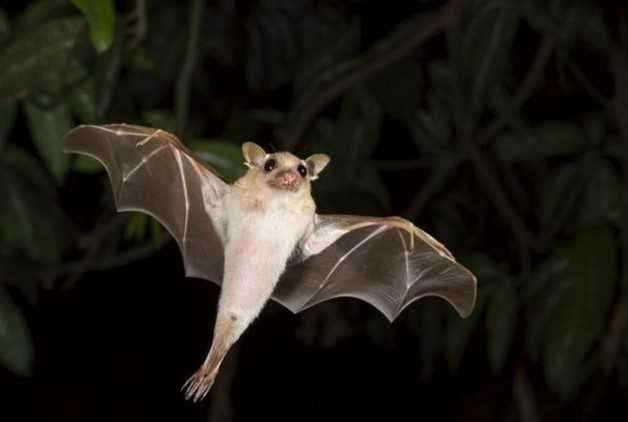The stereotypical image of a bat is often based on vampire stories. In general, there seems to be a public a fear of bats. Most often they are misunderstood and viewed as scary, nocturnal creatures that will get caught in your hair and suck your blood. However, bats are extremely important for our environment. They control insect populations such as mosquitoes and some species of plants rely solely on bats for pollination.
Without bats there would be no tequila! Here's why
Find Your Forecast Search for a location
Friday, June 29, 2018, 1:11 PM - The stereotypical image of a bat is often based on vampire stories. In general, there seems to be a public a fear of bats. Most often they are misunderstood and viewed as scary, nocturnal creatures that will get caught in your hair and suck your blood. However, bats are extremely important for our environment. They control insect populations such as mosquitoes and some species of plants rely solely on bats for pollination.
SUMMER 2018: Visit the Summer Forecast Guide to the Season for the 2018 Summer Forecast, Fall Weather Preview and much more
Nectar-feeding bats are critical pollinators for a variety of plants of great economic and ecological importance. Bats inhabit all regions of Earth, with the exception of Antarctica. With over 1,200 species of bats worldwide, it’s no wonder they have great ecological value and are considered one of the best natural indicators of our environment's overall health.
#Agaves are an essential source of food & habitat for many bat species. Increased demand for #tequila & #mezcal means that agaves are often harvested before they bloom, leaving #bats hungry. Help BCI feed #endangered bats & restore their natural habitats. https://t.co/jEhxrHLESq pic.twitter.com/D0FbkzCJdH — Bat Conservation Int (@BatConIntl) April 12, 2018
Insectivorous bats feed on insects and as a result save the agricultural industry billions of dollars each year. Bats consume insects (free of charge) that are considered pests and harmful to crops. The more insects consumed by bats mean fewer pesticides used by farmers. All eight species of bats found within Ontario are insectivorous.
Nectar-feeding bats are a critical pollinator within our ecosystem. Over 300 species of fruit rely on bats for pollination. Bats that feed on fruit and nectar disperse seeds and pollinate flowers in a wide range of ecosystems, including deserts and rainforests.
Bats are not attracted to the same types of flowers as bees – they tend to like plants that do not give off a strong scent or offer bright colours – which is important for diversified pollination within our ecosystem.
There are 60 species of cacti plants that rely solely on bats for pollination. For example, only bats pollinate the agave plant found in Mexico, therefore without bats there would be no tequila! So next time you’re sipping on a margarita, a cheers is in order for the bats.
Bats are NOT after you, they are after insects. They use echolocation to navigate and find food in the dark. The next time a bat “swoops” down towards you remember, they are looking for insects that may be near you. Humans may inflict more self-harm in their frantic escapes from bats than from a bat itself.
Bats are less of a public health threat than raccoons and skunks. Rabies is perhaps the most common disease associated with bats and other animals such as raccoons, foxes, skunks and even dogs. Exposure to rabies occurs when a rabid animal bites a person.
The economic value of bats and their influence on the biodiversity of this planet through pollination, seed dispersal and insect consumption make them vital to a healthy environment.
Bats are irreplaceable seed dispersers, flying 40km a night spreading pollen + seeds. They are also just wonderful!! pic.twitter.com/otMzSa7neA — Blanche D'Anastasi (@SeaSnakeBlanche) March 7, 2016
Both the destruction of roosts and habitat and the use of pesticides have contributed to the decline of the bat population in Canada. However, a deadly fungal disease called White Nose Syndrome is currently the biggest threat to our bats.
White Nose Syndrome is a rapidly spreading fungus that is impacting migratory bat species across Canada and the United States. Bats roost and hibernate in caves where the fungus responsible for White Nose Syndrome thrives.
The fungus grows over their nose, wings and body. It disrupts the bats during hibernation causing them to burn limited fat reserves. They are then left dehydrated and searching for food in late winter.
The fungal disease has a 90-100% mortality rate within a bat roost cave, which means it effects hundreds of thousands of bats. In some cases, it has completely extricated bat species in the U.S.
White Nose Syndrome has greatly impacted Ontario's eight species of bats, four of which are listed as endangered.
It has been recorded that White Nose Syndrome is one of North America’s most destructive wildlife diseases in the past century.
VIDEO: BATS INVADE AUSTRALIA | MAY 2015:

Rossum81 on June 29th, 2018 at 14:54 UTC »
And yet Bacardi, a rum distiller, is the company that uses a bat for its logo.
Xilean on June 29th, 2018 at 12:45 UTC »
So bats are responsible for at least 8 of my children and one dead hooker
Thekrisys on June 29th, 2018 at 12:25 UTC »
So that's why you get batshit drunk on tequila